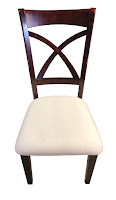 |
| Cedar Chest Finished |
I've refinished many cedar chests since I began working on furniture, but I don't often get cedar chests that are solid cedar. This is actually my second cedar chest. Take a look at my first one by clicking on the link below: (
http://finalefurniture.blogspot.com/2014/10/solid-cedar-chest.html).
Like the first cedar chest, this one had no veneer and was made of solid cedar, although it was a bit larger than the first one. It also had a unique feature, two copper straps on each side, attached with furniture tacks. The copper had been quite tarnished, a natural process which happens over aging, therefore it needed its own restoration.
 |
| Cedar Chest Before |
To clean the copper straps the proper way, I carefully removed them by using my vice grips and pulling off the tacks that held the straps in place.
(Unfortunately eight of the original tacks snapped when I removed them and couldn't be salvaged). There were two long straps on the top and two shorter straps that continued down the front. I cleaned them individually, using copper cleaner, a toothbrush, a wire brush and a lot of elbow grease.
 |
| Left Strap Before |
Eventually I removed the tarnish to reveal the beautiful original copper hidden beneath it. For the tacks, I used my handy dandy wire brush which is attached to my bench grinder and cleaned them up enough to paint them black,
(making a mental note to look for new ones to replace the ones that had broken).
Like all my other stripping projects, I used a strong chemical stripper to remove the old finish on the chest, liberally applying it and using a metal putty knife to scrape away the messy brown goo and swiping it into an empty plastic container. I find this to be the most effective way to get rid of the first layer of
 |
| Left Strap After |
old finish, then follow up with as many applications as needed to remove as much residue as possible.
 |
| Right Strap Before |
Working with solid wood is so much easier than veneer, because
one, it is easier to strip and
two, it looks amazing when you get to the bare wood hidden beneath all that dull old grime. After the surface is no longer sticky with residue, I used steel wool dipped in acetone to remove any remaining chemicals before sanding. I always start out with a 100-150 grit sandpaper, eventually working up to a 220 grit, which gives the wood a smooth surface which will better accept the stain. After the sanding was complete, I wiped it down with a rag dipped in acetone or laquer thinner and it was ready for stain, my favorite part! This cedar chest didn't need stain, so I left it natural, but applied three coats of semi-gloss polyurethane to protect the surface.
Quick Tip: don't skimp on brushes when applying polyurethane! A cheap brush will not give you the quality and look your furniture deserves. Use a good brush with thick bristles and keep it clean between uses by soaking it in acetone and wrapping it in a paper towel. This will prolong your brush for many applications.
One of the rear legs was split in two, so I removed all the legs and refinished them each separately. The wheels had to come off, so Jim cut them with a bandsaw because they were impossible to pull out. The split wheel was attached with a "molly bolt," which expanded into the pre-drilled hole, making it impossible to remove without further
 |
| Right Strap After |
damaging the leg. They too were made of cedar. I glued the broken leg back together, clamped it with my bench vice and screwed it securely back into the cedar chest after it was refinished.
Reassembling the individually restored components of any furniture project is always my favorite part, this one being no exception. The shiny, clean copper straps added a special feature to this old trunk and the painted black tacks gave it character. Luckily I was able to locate the exact same tacks at my local hardware store! They were called "furniture tacks," which are different from household tacks because they have a longer tack point and a rounded head.
Working on this cedar chest was quite satisfying, because hidden under years of old finish and scratches, was a gorgeous piece of
aromatic furniture. The most confusing part of the restoration process though, was I didn't know if I should be hanging in a closet or running on a hamster wheel...😉

























